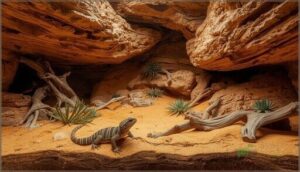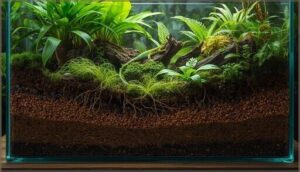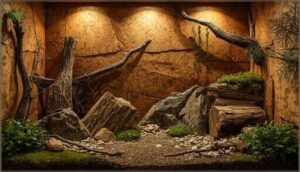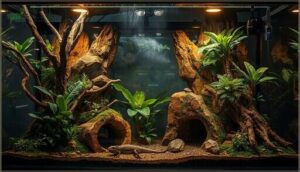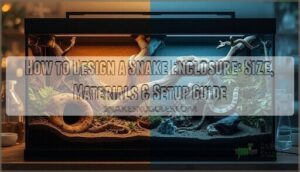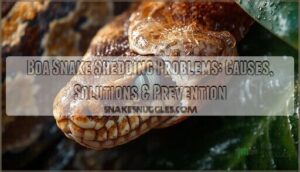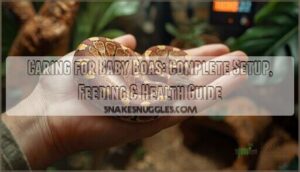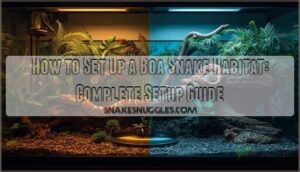This site is supported by our readers. We may earn a commission, at no cost to you, if you purchase through links.
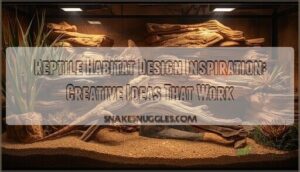
Your bearded dragon spends most of its waking hours scanning the glass walls of its enclosure, tongue-flicking at invisible boundaries while the same plastic hide sits unused in the corner. This behavior isn’t random restlessness—it’s a clear signal that the habitat lacks the visual complexity and functional zones reptiles instinctively seek.
Well-designed reptile habitat design inspiration goes beyond aesthetics; it confronts species-specific thermal needs, behavioral enrichment, and the physiological mechanisms that govern everything from shedding cycles to stress hormone regulation.
Whether you’re recreating the layered canopy of a Costa Rican cloud forest or the thermal extremes of a Sonoran Desert outcrop, the right design framework transforms static enclosures into active environments that support natural behaviors and metabolic function.
Table Of Contents
- Key Takeaways
- Creative Themes for Reptile Habitats
- Functional Backgrounds and Visual Enhancements
- Innovative Substrates and Flooring Ideas
- Enclosure Features That Inspire Exploration
- Species-Specific Design Inspirations
- Frequently Asked Questions (FAQs)
- What is a DIY reptile enclosure?
- What happened to custom reptile habitats?
- How do you create a natural habitat for arboreal reptiles?
- How do you customize a reptile shelf?
- How often should habitat themes be rotated?
- Can reptiles recognize their owners visually?
- What colors calm stressed reptiles most?
- Do reptiles prefer live or artificial plants?
- How to photograph reptile habitats effectively?
- Conclusion
Key Takeaways
- Successful reptile habitat design requires precise thermal gradients and species-specific environmental controls—desert species need 120°F basking zones with 20-40% humidity, while tropical species thrive at 75-85°F with 60-80% humidity and moisture-retaining substrates.
- Bioactive substrates with springtails and isopods create self-sustaining ecosystems that reduce maintenance by up to 70% while supporting natural behaviors, nutrient cycling, and proper humidity levels without constant human intervention.
- Textured backgrounds, vertical climbing structures, and multiple hiding spots aren’t decorative extras—they’re functional necessities that improve shedding efficiency, reduce stress-related illness by 24%, and increase natural locomotion by 35% in arboreal species.
- Smart integration of UV-reflective materials, automated climate controls, and proper substrate selection directly impacts measurable health outcomes by supporting thermoregulation, calcium metabolism, and stress hormone regulation in captive reptiles.
Creative Themes for Reptile Habitats
When you’re designing a reptile habitat, the theme you choose sets the foundation for everything else—from substrate selection to lighting placement. Your enclosure can mirror a tropical rainforest canopy, a sun-baked desert floor, or even a sleek modern display that prioritizes function without sacrificing visual appeal.
Here are five creative themes that balance your reptile’s biological needs with practical design elements.
Naturalistic Forest and Jungle Designs
When you’re drawn to forest and jungle themes, you’re tapping into some of the richest reptile habitat design possibilities. Creating a natural habitat means layering arboreal enrichment ideas like elevated branches with species-specific forests that mirror native vegetation density. Naturalistic decor transforms standard reptile enclosure design into living ecosystems.
Your forest enclosure size should support thermal gradients—aim for 70°F to 85°F ambient zones with basking spots reaching 95°F. Jungle humidity control between 50% and 80% pairs perfectly with bioactive terrarium design using springtails and leaf litter. To guarantee success, selecting the right terrarium size is vital for the animal’s well-being.
Desert and Arid Landscape Inspirations
Desert and arid landscape designs require precise shelter design and substrate innovation to replicate extreme conditions. You’ll need basking zones reaching 120°F for species like Mali Uromastyx, while ambient areas stay between 70°F and 90°F. Desert lighting needs include high-output UVB to support calcium metabolism.
Current arid decor trends emphasize naturalistic decor choices:
- Rock formations and caliche caves mimicking natural shelter structures
- UV-resistant coatings on terrarium decoration for longevity under intense lighting
- Modular decor materials allowing customizable desert microhabitats
- Artificial plants (29% of market) providing low-maintenance visual authenticity
- Decorative stones and sands (22% of market) creating authentic substrate layers
Arid adaptations in wild reptiles—reduced water loss, specialized morphology—inform reptile habitat design. The market is growing due to these trends. DIY reptile enclosures benefit from incorporating burrow-like structures that reduce home range stress and improve species survival rates.
Aquatic and Semi-Aquatic Setups
Shifting from arid extremes, aquatic and semi-aquatic setups demand precision in water quality and substrate design. You’ll want sloped river pebbles rising from water to land—this 1:2 ratio mimics natural shorelines while supporting thermoregulation.
Maintain 75°F to 85°F water temperatures and 70% to 85% humidity control. Flat basking rocks and live plants address enrichment needs, transforming your reptile enclosure into a functional, naturalistic vivarium that follows current setup trends in terrarium decoration.
Bioactive and Self-Sustaining Terrariums
Unlike aquatic designs, bioactive substrates create self-regulating ecosystems where microfauna roles become the backbone of your vivarium setup. You’ll layer 4-6 inches of organic soil with springtails and isopods—these cleanup crews reduce your maintenance by up to 70%.
Plant integration stabilizes humidity while substrate composition fosters ecosystem balance.
This terrarium design approach delivers long-term sustainability, with some bioactive reptile habitats thriving for decades through natural ecosystem creation.
Modern and Minimalist Habitat Styles
When you prioritize cleanliness and functionality, minimalist reptile enclosure designs simplify your maintenance routine. These terrarium design approaches use neutral color schemes—whites, greys, earth tones—in 45% of setups, while sustainable materials like recycled acrylic guarantee material safety.
Space planning emphasizes open areas that reduce stress, and modular vivarium décor lets you customize your reptile habitat without visual clutter or excess complexity.
Functional Backgrounds and Visual Enhancements
The walls of your reptile’s enclosure aren’t just for show—they’re working elements that directly influence behavior, health, and comfort. When you choose backgrounds and visual enhancements thoughtfully, you’re creating surfaces that assist with shedding, support natural climbing instincts, and even align with how your reptile perceives its surroundings.
Here are three functional approaches that merge design with purpose.
Textured Backgrounds for Shedding and Climbing
Textured backgrounds aren’t just eye candy—they’re functional tools for shedding assistance and climbing performance. Rough surfaces let your reptile rub off old skin naturally while improving grip.
When you’re planning your reptile habitat setup, choose food-grade resin or sealed foam for material safety. These climbing structures boost exploration in your reptile enclosure and support better thermoregulation.
Design trends now favor customizable 3D panels that deliver real functional benefits without sacrificing durability.
UV-Reflective Decor for Reptile Perception
Your reptile’s vision extends into ultraviolet wavelengths you can’t see—most species detect 300–400 nm UV light through tetrachromatic color vision.
UV decor benefits include improved behavioral pattern recognition and foraging efficiency, with studies showing 40% increases in courtship behaviors.
Choose reflectance material safety by selecting titanium dioxide coatings for your reptile enclosure. Position UV-reflective decor along habitat lighting gradients where your reptile spends 60% of active time for best animal enrichment strategies.
Safe Materials for Healthy Environments
You can’t afford mistakes when building your reptile habitat—wrong materials kill. Choose food-grade PVC or sealed plywood that meet ASTM F963 standards for regulatory compliance. Safe adhesives like aquarium-grade silicone protect your reptile’s respiratory system from plastic off-gassing and toxic fumes.
Smart decor materials for your reptile enclosure:
- Resin-sealed hardwoods resist wood treatment contamination
- Grapevine branches (70% commercially safe) for natural materials
- Spider plants and Rhipsalis—never Euphorbia toxic plants
- HDPE lasting 20+ years without degradation
- Titanium dioxide coatings meeting reptile needs safely
Innovative Substrates and Flooring Ideas
The floor of your reptile’s enclosure does more than just provide a surface—it influences humidity, fosters natural behaviors, and can even simplify your maintenance routine. Choosing the right substrate means balancing your species’ needs with practical considerations like cleaning frequency and safety.
Here are some creative flooring ideas that combine function with thoughtful design.
Bioactive Substrate Inspiration
Think of bioactive substrates as living ecosystems within your reptile enclosure. You’ll create a thriving vivarium through careful layer composition—mixing soil, clay, and organic matter to support nutrient cycling.
Microfauna balance becomes critical here: springtails and isopods handle decomposition while improving moisture management.
This ecosystem creation transforms your reptile habitat into a self-sustaining environment that aids temperature regulation naturally.
Sustainable and Eco-Friendly Flooring Options
You can make responsible flooring choices that protect your reptile and the environment. Natural fiber flooring like hemp and coconut coir resists mold while maintaining proper humidity.
Recycled PET carpets divert plastic waste—one square foot recycles up to five bottles. Biodegradable substrates and compostable reptile mats decompose within 60–120 days.
Chemical-free alternatives reduce toxicological responses by 42%, making sustainable terrarium practices both ethical and practical.
Custom Reptile Carpets and Mats
Beyond broad eco-conscious choices, you can tailor flooring directly to your terrarium design with custom reptile carpets and mats. These carpets balance hygiene benefits with carpet material safety—synthetic fibers cost $10–$15 per square foot, while durable natural blends reach $20–$30. Design trends now include UV-reflective patterns and thermal insulation integration, creating functional reptile environments where cost analysis favors long-term reusability over frequent substrate replacement.
- Material Safety First: Choose non-toxic polyester, nylon, or wool-blend carpets designed for reptile enclosures.
- Hygiene Benefits: Washable surfaces reduce parasites and prevent substrate ingestion in your custom terrariums.
- Cost Analysis: Higher upfront costs deliver years of use compared to disposable substrates.
- Design Trends: UV-reflective, habitat-mimicking patterns support natural behaviors in reptile habitats.
- Thermal Insulation: Carpets stabilize enclosure temperatures, integrating seamlessly with heating systems.
Substrate Selection for Specific Species
Choosing the right substrate for your reptile habitat depends entirely on whether you’re housing desert dwellers or tropical species. Desert substrate like fine quartz sand meets burrowing needs for leopard geckos, while tropical bedding such as coconut coir retains 65–72% moisture for chameleons.
Safety concerns arise when non-reptile-grade sand causes impaction in 26% of cases, directly affecting hygiene impacts and reptile care outcomes in your vivarium.
Enclosure Features That Inspire Exploration
Your reptile’s enclosure shouldn’t just house them—it should inspire them to move, explore, and behave naturally. The right combination of climbing zones, hiding spots, temperature gradients, and smart technology transforms a static container into an active environment.
Let’s look at the specific features that encourage this kind of active, healthy engagement.
Vertical Climbing Structures and Platforms
For arboreal species, climbing materials like branches and cork bark transform your reptile habitat from basic to behaviorally complete.
Vertical enrichment increases locomotion by 35% in tree-dwelling reptiles, directly improving physical welfare through enhanced muscle tone and thermoregulation.
Your vivarium décor should include secure platforms positioned 15-30 cm from heat sources, with structures supporting three times your reptile’s weight to prevent collapse.
Secure and Stylish Shelters
Your reptile’s hiding spots aren’t just decorative—they’re physiological necessities that reduce stress-linked illnesses by 24%. Cork bark shelters around £30 offer naturalistic escape-proof design, while PVC hides outperform rock caves by 34% in usage. Ground-level shelters account for 77% of occupancy across species.
Hiding spots are physiological necessities that reduce stress-linked illnesses by 24%, with PVC hides outperforming rock caves by 34%
Choose materials like sealed PVC that reduce bacterial growth by 60%, balancing material safety with aesthetic integration in your vivarium décor.
Basking Areas and Thermoregulation Zones
Effective thermoregulation hinges on proper basking areas within your reptile enclosure. Position raised platforms 15-30 cm from heat sources, creating thermal gradients of 20-30°F between warm and cool zones. Non-porous basking materials prevent bacterial buildup while supporting behavioral thermoregulation—your reptile’s ability to self-regulate temperature influences everything from digestion to evolutionary fitness.
Corner placements increase floor space while promoting species diversity through varied temperature microclimates and nearby hides.
Integrating Environmental Controls With Design
When you blend smart thermostats and wireless sensors into your terrarium design, climate integration becomes invisible yet precise. Automated monitoring tracks humidity gradients and thermoregulation zones while remote management lets you adjust parameters from anywhere.
Strategic sensor placement maximizes energy efficiency by targeting only active areas of your reptile habitat, ensuring your reptile enclosure maintains ideal conditions without constant manual intervention.
Species-Specific Design Inspirations
Every reptile species brings its own set of needs to the table, and your enclosure design should reflect that reality. What works for a corn snake won’t cut it for a chameleon, and desert dwellers need a completely different setup than their tropical cousins.
Let’s look at how you can tailor your habitat designs to match the specific requirements of different reptile groups.
Corn Snake Habitat Concepts
Creating a successful corn snake habitat means balancing space with function. Your enclosure should be at least four feet long, giving your snake room to stretch and explore. Here’s what makes a corn snake setup truly work:
- Enclosure size matching snake length—minimum 4x2x2 feet for adults
- Thermal gradient from 88–92°F basking down to 75–82°F cool zones
- Bioactive substrate blends (70% topsoil, 20% sand, 10% clay) with springtails
- Habitat enrichment through climbing branches, multiple hides, and shedding aids
Self-sustaining setups cut maintenance while supporting natural corn snake care behaviors.
Arboreal Reptile Enclosure Ideas
Think of arboreal reptile habitats as vertical real estate—every inch upward matters. Your enclosure should prioritize climbing structures like natural branches and dense bamboo, creating layered pathways through the vertical space.
Glass or PVC reptile enclosures excel at humidity control for rainforest species. Bioactive substrates with coir and leaf litter support live plants that improve aesthetic design while maintaining the moisture these tree-dwelling reptiles need.
Customizing for Tropical Vs. Desert Species
Your reptile habitat needs opposite approaches for tropical versus desert species. Tropical custom terrariums demand humidity gradients of 60–80% with moisture-retaining substrates like coconut husk, while desert reptile enclosures require arid flooring and 20–40% humidity.
Temperature zones differ dramatically—tropical vivarium décor allows for 24–32°C ranges, but desert setups need 38–43°C basking areas.
Lighting needs and hydration methods also split: tropical species thrive with misting systems creating a natural habitat, while desert reptiles prefer shallow water dishes.
High-End and Automated Enclosure Trends
Premium reptile enclosures now come equipped with features once reserved for science labs. Smart climate systems, automated lighting with programmable UVB cycles, and IoT controls let you manage your habitat from anywhere. Market expansion reflects this shift—high-end custom terrariums featuring feeding technology and app-based monitoring are redefining reptile enclosure design:
- Real-time data analytics track up to 10 sensor zones per terrarium design
- Automated lighting appears in 57% of premium Zen Habitats-style setups
- IoT controls manage 19 distinct functions through single platforms
- Remote feeding reduces manual intervention by 60%
- Smart systems maintain 99.5% uptime annually
Frequently Asked Questions (FAQs)
What is a DIY reptile enclosure?
You don’t need store-bought options—a DIY reptile enclosure is a custom terrarium you build yourself using materials like PVC, acrylic, or glass.
This approach offers species-specific design benefits, cost savings, and complete control over your reptile habitat.
What happened to custom reptile habitats?
Custom reptile habitats haven’t disappeared—they’ve evolved. Market growth shows niche expansion as hobbyists prioritize species-specific terrarium design despite cost barriers.
Material sustainability concerns now shape reptile enclosure design, while customization benefits drive premium reptile habitat demand.
How do you create a natural habitat for arboreal reptiles?
Building upward matters most. Building with purpose matters equally.
You’ll need sturdy branches, moisture-retentive substrates, and live plants that tolerate humidity.
Position climbing structures at varied angles to encourage natural movement patterns.
How do you customize a reptile shelf?
You can choose PVC or replica rock shelves for durability, then drill precise mounting holes with adhesive support.
Add adjustable basking zones, smart thermometers, and easy-clean substrates to improve functionality and reptile wellbeing.
How often should habitat themes be rotated?
For best reptile care, promotes habitat themes every three to four months.
This rotation frequency environmental enrichment, reduces abnormal animal behavior, aligns with species preferences, and improves long-term welfare through enhanced visual enrichment and terrarium maintenance.
Can reptiles recognize their owners visually?
Bearded dragons and iguanas demonstrate visual reptile acuity, tracking familiar owners by movement and appearance.
Species recognition variance exists—turtles use sight and sound, while snakes favor chemical cues over behavioral owner responses for reptile bonding cues.
What colors calm stressed reptiles most?
Calming blue hues and green vegetation effects, especially in naturalistic color schemes with high habitat color brightness, consistently reduce stress in reptiles.
Species-specific preferences matter—soft blues, muted greens, and gentle grays support reptile care, health, and overall animal welfare.
Do reptiles prefer live or artificial plants?
Most reptiles don’t distinguish between live and artificial plants based on appearance alone. Their preference hinges on functional benefits.
Live plants boost humidity and enrichment in bioactive setups, while artificial options simplify reptile care and vivarium décor maintenance.
How to photograph reptile habitats effectively?
To photograph reptile habitats effectively, use angled lighting techniques and macro camera settings for sharp detail. Reduce glare with polarizing filters and close lens placement.
Prioritize composition focus and ethical welfare, ensuring terrariums and animal enclosures reflect natural pet habitats.
Conclusion
Your enclosure isn’t underperforming—it’s simply waiting for the structural upgrades that align with how your reptile processes its environment. Effective reptile habitat design merges thermal engineering with behavioral ecology, creating zones where thermoregulation, exploration, and stress reduction happen simultaneously.
The difference between adequate housing and ideal captive conditions lies in understanding that every texture, gradient, and vertical plane either reinforces or bolsters physiological function. Design with intention, and the results become measurable in activity patterns and long-term health outcomes.
- https://www.accio.com/business/pvc-reptile-enclosure-trends
- https://www.datainsightsmarket.com/reports/reptile-enclosure-1905831
- https://finance.yahoo.com/news/reptile-enclosure-market-reach-us-180300476.html
- https://www.petbusinessworld.co.uk/trade-news/distributors/monkfield-study-reveals-energy-cost-of-keeping-reptiles.html
- https://www.nespthreatenedspecies.edu.au/media/tcln3n2v/1-2-artificial-refuges-findings-factsheet_v5.pdf


